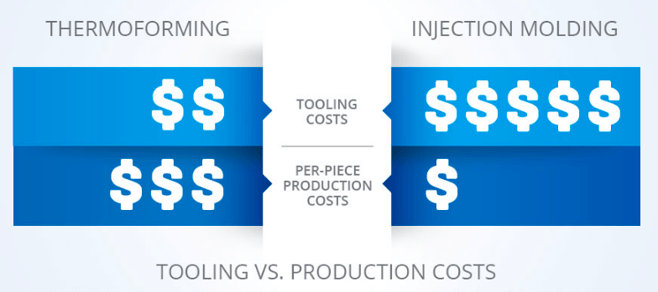For decades, the automotive industry has been dominated by the big players. The barriers to entry have historically been formidable, and nearly impossible, for small, new entrants to overcome. In recent years, though, advances in manufacturing technology have made it possible for smaller companies to carve out their own niche and compete with the big boys.
At Deufol, we’re fortunate to work closely with a number of automotive manufacturers. Some make parts, while others construct the whole vehicle. All of them are innovators helping to push the industry forward.
Injection molding is efficient in large quantities.
For smaller-size runs, it proves problematic.
Despite advances in manufacturing, there’s still one tough dilemma that many manufacturers face. It’s how to best produce plastic parts and components. For years, injection molding has been the preferred method. However, injection molding comes with real challenges that can be problematic for smaller automotive companies.
Fortunately, there is an alternative available. Thermoforming has also benefitted from technological advancements in recent years, and it is now a very real option in the automotive industry. Not every thermoforming company, however, is a good choice for automotive parts. There are a number of challenges that still exist in using thermoforming as parts and components for vehicles.
Is thermoforming right for your automotive parts? Possibly. Check out the benefits below, along with the requirements you should look for in any thermoform company.
Why Thermoform Instead of Injection Moulding?
Traditionally, injection moulding has been an effective way for automotive parts manufacturers to produce plastic parts. That is, of course, if you are a large manufacturer who produces tens of thousands of parts or more.
Injection moulding is efficient in large quantities. For smaller-size runs, it proves problematic. The reason is because the mold may cost hundreds of thousands of dollars to produce. Clearly, to make it cost-effective, you need to spread that sum out over a large volume of parts.
Another challenge is that to run an injection moulding process, you often have to produce a large quantity per run. So you may only need 100 parts, but you have to run 1,000 at a minimum. Your options are to either wait until you have a need for 1,000 or let the extra 900 sit on a warehouse shelf. Neither option is appealing.
(Courtesy: Ray Products Company Inc.)
Finally, you may be in a developmental phase, like some of our customers. You’re constantly making slight changes to parts or components. You’re experimenting to see what works. What happens, though, when these changes alter the part specifications? You already have a mold for the first set of specs. You can’t invest hundreds of thousands additional dollars into a new mold.
For all of these reasons and more, thermoform can be a much more attractive production option. With thermoform, the mold itself may only run you a few thousand dollars. That makes it cost-efficient to use on a small batch of hundreds or even dozens of parts.
Additionally, thermoform molds are easy to alter. If you’re in prototype or developmental mode, you can quickly change your mold or create a new one to accommodate your new product specs. That gives you the flexibility to continue developing your product as much as needed.
How to Find an Automotive Thermoform Partner
At this point, you may be sold on the idea of using thermoform part production rather than injection moulding. Now all that’s left is to find a thermoform company, right?
Not so fast. Just because a company can provide thermoform services doesn’t mean they’re right for your automotive job. You likely know better than anyone what kind of regulations exist in your industry. Your partner has to comply with all of those same rules. Not every thermoform company has the ability to do so.
➔ A few questions to consider as you look for a thermoform partner:
—What kind of risk protection tools do they have in place to manage defects?
Ultimately, you’re not just looking for a partner in production, but also a partner in risk. The company’s production process plays a big role in protecting your part quality. If their process isn’t up to par, your product could suffer.
Do they have insurance to cover any liability on their end? What risks are their responsibilities and which are yours? How will you and they negotiate liability in the case of a defect?
—How do they provide transparency through the production process?
Traceability is critical in the automotive industry, not only for supply chain efficiency, but also for safety and quality control. If a part ends up being defective, you have to be able to trace it all the way back down its supply path so you can identify where and how the defect happened.
 You probably have systems in place to track parts through your design process, but what about when that part is produced by an outside partner? What systems do they have to ensure transparency and traceability?
You probably have systems in place to track parts through your design process, but what about when that part is produced by an outside partner? What systems do they have to ensure transparency and traceability?
The right partner should have software that allows them to track parts at every step of the process. For instance, at Deufol we use a software program that allows us to scan and track parts, containers, and packages as they move through the process and the supply chain. Our software integrates with SAP and other platforms, so you can check the status of your parts or trace a part’s path with just a few clicks of the mouse.
—How long will they keep you mold available?
This may not be an obvious question but it’s an important one in the automotive industry. You know as well as anyone that cars you produce today could still be in use five, 10, or even 20 years from now. That means there will be a demand for replacement parts well into the future.
Those replacement parts will have to be produced, even if you’re no longer producing the car. You don’t want to restart the entire mold and thermoform process just to send a few replacement parts.
For the first time in decades, lower-volume
manufacturers are able to leverage technology and introduce competitive, innovative vehicles to the market.
What is more effective and efficient is for your partner to guarantee to keep the thermoform setup available for a specific period of time. Any thermoform company that is serious about working in the automotive industry should be able to make this guarantee.
The automotive industry is going through a period of massive change and disruption. For the first time in decades, lower-volume manufacturers are able to leverage technology and introduce competitive, innovative vehicles to the market. Plastic part production shouldn’t be a restriction on your ability to innovate and grow. There are alternatives to injection moulding. You just have to find the right partner. ![]()








Let Us Know What You Thought about this Post.
Put your Comment Below.